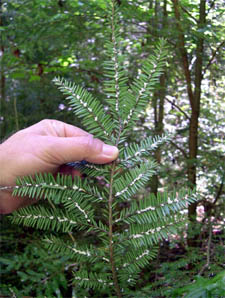| About 2,500 predator beetles were released May 7 in the Laurel Fork Creek
drainage area of Jocassee Gorges near the Foothills Trail in Pickens
County. These insects feed on hemlock woolly adelgids, which have been
decimating Eastern hemlock populations along the East Coast.
The team that released the predator beetles was a cooperative partnership
made up of representatives from the U.S. Forest Service, S.C. Forestry
Commission and S.C. Department of Natural Resources (DNR).
The DNR manages
the Jocassee Gorges property in Pickens and Oconee counties. The predator |

Photo SCDNR Greg Lucas © |
beetles, which can cost up to $5 apiece, were reared in a private lab in
Pennsylvania. The U.S. Forest Service furnished them to DNR at no charge.
The predator beetles are native to Japan and feed on adelgids there. These
beetles are not the common ladybug that sometimes mass around homes-the
predator beetle released in Jocassee Gorges is about a tenth the size of
the well-known ladybug and never leaves the forest.
"This is an important first step in helping to control hemlock woolly
adelgids in Jocassee Gorges," said Rusty Rhea, an entomologist with the
U.S. Forest Service based in Asheville, N.C. "It's not a silver bullet or a
cure-all by any means. These predator beetles will never eliminate the
adelgids, but rather they can slow the adelgids' spread and give the trees
a fighting chance."
Hemlock woolly adelgids have been in the United States since 1924. A native
of Asia, it recently moved rapidly into the Southern Appalachians and
decimated the Eastern hemlock in areas like Shenandoah National Park in
Virginia. The adelgids cannot fly and spread by the immature "crawler" life
stage. These small immature adelgids crawl, are blown in winds or are
possibly spread by songbirds. By feeding on the internal portions of young
twigs, the hemlock woolly adelgid retards or prevents tree growth. This
causes needles to discolor from deep green to grayish green, and to drop
prematurely. The loss of new shoots and needles seriously impairs tree
health. Defoliation and tree death can occur within five to seven years of
initial infestation.
Foresters and scientists say that unless the hemlock woolly adelgid is
controlled, it could prove as devastating to hemlocks in the forest as
American chestnut blight. Chestnut blight was introduced into the United
States in 1900 and virtually wiped out the dominant tree in the Southern
Appalachians by 1950. Chemical control of the hemlock woolly adelgid is
possible in urban settings, but biological control of the adelgid is the
only real option in the forest.
The shade of Eastern hemlocks is vitally important in cooling Jocassee
Gorges trout waters. Although systematic surveys are not yet complete, the
hemlock woolly adelgid has been found in many areas of the 44,000-acre
Jocassee Gorges lands.
Demand for the predator beetles far exceeds demand, and several new labs
are gearing up for production this year. Clemson University has begun
production of the predator beetles, and a few public and private labs will
produce about a half-million or so this year, to be distributed among 13
Eastern states that have infestations. Clemson University has one of the
best production units for the predatory beetles.
- Written by Greg Lucas -
|